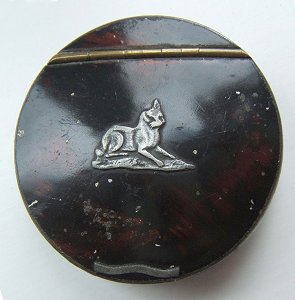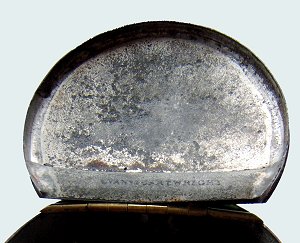EVANS AND CARTWRIGHT
by Liza Antrim
| This text and the images of furniture are copyright of Liza
Antrim, 2006, and may not be downloaded or reproduced in any medium
without the written permission of the author. |
| John Evans was listed as a toy
and Japan manufacturer in Dudley Road, Wolverhampton in
1816, and by 1827 he and his stepson Sidney Cartwright
were in business there together as toy manufacturers,
factors and wood turners. This was their heyday, when
they employed nearly 160 people, many of them children.
By the time Sidney Cartwright had taken over, in 1842,
business had taken a down-turn, due partly to the
general depression, and also to the Americans stopping
imports of English toys, having started to manufacture
their own. The work force had shrunk to sixty, but the
firm continued for quite some time, until eventually
going out of business in the 1870s or 1880s. |
|
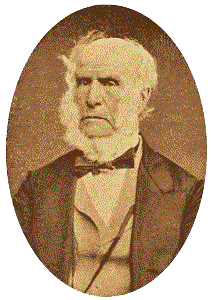
Sydney Cartwright |
Cartwright appears to have been a
good employer. He was a Poor Law Guardian, and felt
strongly about education for children up to the age of
nine but was realistic enough to realise that their
earnings after that age became too important to be
dispensed with.
He was an eminent citizen of
Wolverhampton, involved in banking and mining, acting as
a magistrate and supporting the Wolverhampton Art
Gallery and Museum, which he endowed and to which he (or
his widow) bequeathed his collection of paintings. He
died in 1882. |
| The tin furniture which the
factory produced had for many years been thought to be
French, but a lucky purchase in an auction of a lot
which the auctioneer described as a “box of old junk”,
gave us the first clue that the real story was quite
different. My eagle-eyed daughter noticed some faintly
impressed letters on one of the chair legs, and we
managed to make out ‘..ANS & CARTWRIGHT. Margaret
Towner, a friend, put 14 and 2 together, and tracked
down the factory to Wolverhampton.
The Ordnance survey
map for 1901 still shows the site of the toy factory on
the Dudley Road, opposite Cartwright Street where
presumably Sidney provided housing for many of his
workers. This area has sadly all been demolished. The
factory site is now partly a car park and partly a
vacant plot beneath a hoarding (how wonderful it would
be if some industrial archaeologists decided it would be
an interesting place for a dig!). |

Chair by Evans
and Cartwright |
|

Table by Evans and Cartwright |
The pieces which the firm
produced were mostly of rolled or punched tin-plate,
with many of the patterns being used over and over again
for different articles.
The Japanned finish was
predominantly in the familiar “foxy red” wood grain,
although some pieces appear in a dark red lustre. The
washstands, though, often seem to be painted in bright
colours, with flowers and leaves.
We now know for sure what they made
for the doll’s house (my main interest) but have never
(knowingly) seen any of the other toys which were made
at the factory known affectionately as “Whistle Hall”.
|
| The site of Evans and
Cartwright's factory, now with the hoarding and the car
park beyond it. |
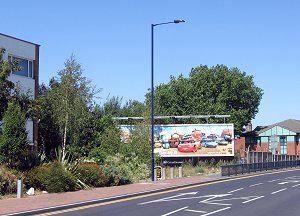 |
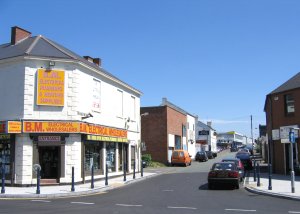 |
Cartwright Street. The
corner building may possibly date from from Sydney
Cartwright's time but the rest has now gone. |
Robert Cordon Champ has kindly provided us with
these photos of a snuff box in his possession:
Bob describes this as "a circular, convex snuff box with
tortoiseshell finish, about 2 1/2 inches in diameter and clearly
marked 'Evans & Cartwright' on the internal hinge plate. The box is
very well-made and finished, with a small applique mount of a cat
with a bird in its mouth in the centre of the lid. Both lid and base
are convex as is the spacer (side) between the two. The inside
finish is tin as is usual, the mark stamped in very small
upper-case".
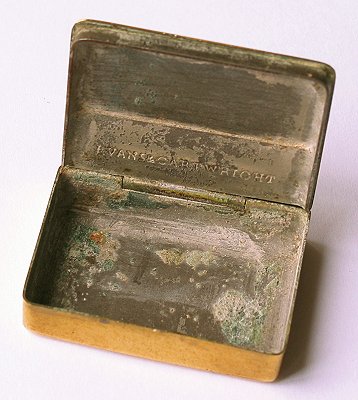 |
|
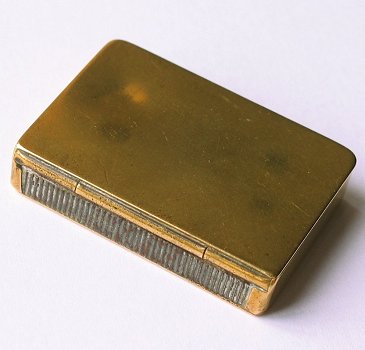
A little Evans & Cartwright
brass vesta case, lined in tin.
Courtesy of |
| If you have any further information about the
company, please let us know. |
|
 |
|
Return to
the
list of manufacturers |
|



